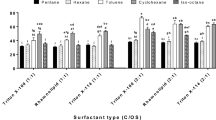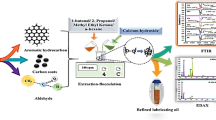Abstract
The influence of experimental factors in solvent extraction for hydrocarbon recovery from oil sludge was investigated using an orthogonal experimental design. The results indicated that temperature, solvent type, solvent blend, solvent to sludge ratio, and treatment duration had significant effects on hydrocarbon recovery. In this investigation, a response surface methodology used to optimize the conditions required to recover hydrocarbons from oily sludge. In addition, the effectiveness of solvent extraction using solvent blends of methyl ethyl ketone (MEK) and xylene for recovery and upgrading of oily sludge has been determined. Oily sludge used here consisted of 63% of its weight petroleum hydrocarbons. Based on the experimental data, a full quadratic model was generated. Optimization of influential parameters was conducted through the fitted model. As determined by the fitted model, the factors such as temperature, mixing time, MEK, and xylene to sludge ratios for optimum oil sludge recovery with solvent extraction method must be fixed at 49.28 °C, 22 min, 6.04 to 1, and 6.4 to 1, respectively. Under the optimum conditions, 64.04% extraction yield achieved using solvent blends of MEK and xylene according to the model. Using the combination of MEK and xylene for recovery of oil sludge, a maximum extraction yield of 61.44% as petroleum hydrocarbons obtained during experiments. Based on the results, combination of MEK and xylene as solvent blend demonstrated significant effect on hydrocarbon recovery in 6 to 1 and higher ratios.










Similar content being viewed by others
References
Al Zubaidi, I. (2018). Heavy fuel oil recovery from oil sludge by multiple extraction processes. Progress in Petrochemical Science, 1. https://doi.org/10.31031/PPS.2018.01.000517.
Al-Doury, M. M. I. (2019). Treatment of oily sludge using solvent extraction. Petroleum Science and Technology, 37(2), 190–196.
Al-Zahrani, S. M., & Putra, M. D. (2013). Used lubricating oil regeneration by various solvent extraction techniques. Journal of Industrial and Engineering Chemistry, 19(2), 536–539.
Cheremisinoff, N. P., & Rosenfeld, P. (2010). Handbook of pollution prevention and cleaner production. Chapter 1-The petroleum industry (pp. 1-97).
da Silva, L. J., Alves, F. C., & de França, F. P. (2012). A review of the technological solutions for the treatment of oily sludges from petroleum refineries. Waste Management & Research, 30(10), 1016–1030.
El Naggar, A. Y., Saad, E. A., Kandil, A. T., & Elmoher, H. O. (2010). Petroleum cuts as solvent extractor for oil recovery from petroleum sludge. Journal of Petroleum Technology and Alternative Fuels, 1(1), 10–19.
Hassanzadeh, M., Tayebi, L., & Dezfouli, H. (2018). Investigation of factors affecting on viscosity reduction of sludge from Iranian crude oil storage tanks. Petroleum Science, 15(3), 634–643.
Hu, G. (2016). Development of novel oil recovery methods for petroleum refinery oily sludge treatment. University of Northern British Columbia. https://doi.org/10.24124/2016/bpgub1119.
Hu, G., Li, J., & Zeng, G. (2013). Recent development in the treatment of oily sludge from petroleum industry: A review. Journal of Hazardous Materials, 261, 470–490.
Hu, G., Li, J., Huang, S., & Li, Y. (2016). Oil recovery from petroleum sludge through ultrasonic assisted solvent extraction. Environmental Science and Health, Part A, 51(11), 1–9.
Liang, J., Zhao, L., Du, N., Li, H., & Hou, W. (2014). Solid effect in solvent extraction treatment of pre-treated oily sludge. Separation and Purification Technology, 130, 28–33.
Lodungi, J. F., Alfred, D. B., Khirulthzam, A. F. M., Adnan, F. F. R. B., & Tellichandran, S. (2016). A Review in oil exploration and production waste discharges according to legislative and waste management practices perspective in Malaysia. International Journal of Waste Resources, 7(1), 260.
Montgomery, D. C., Runger, G. C., & Hubele, N. F. (2010). Engineering Statistics, 5th Edition. John Wiley & Sons, Incorporated.
Nezhdbahadori, F., Abdoli, M., Baghdadi, M., & Ghazban, F. (2018). A comparative study on the efficiency of polar and non-polar solvents in oil sludge recovery using solvent extraction. Environmental Monitoring and Assessment, 190(7), 389.
Reis, J. C. (1996). Environmental control in petroleum engineering. Gulf Professional Publishing. https://doi.org/10.1016/B978-0-88415-273-6.X5000-8
Sinnathambi, C. M., Ahmed, R., & Eldmerdash, U. (2015). N-hexane, methyl ethyl ketone and chloroform solvents for oil recovery from refinery waste. Applied Mechanics and Materials, 699, 666–671.
Taiwo, E. A., & Otolorin, J. A. (2009). Oil recovery from petroleum sludge by solvent extraction. Petroleum Science and Technology, 27(8), 836–844.
Taiwo, E. A., & Otolorin, J. A. (2016). Solvent blend performance in hydrocarbon recovery from Nigerian tank bottom sludge. International Journal of Engineering and Technologies, 9, 20–28.
Zubaidy, E. A. H., & Abouelnasr, D. M. (2010). Fuel recovery from waste oily sludge using solvent extraction. Process Safety and Environmental Protection, 88(5), 318–326.
Acknowledgments
The authors would like to thank Mr. Farzan Ghazban of the University of Waterloo for his valuable discussionm and his assistance is greatly appreciated. Thanks are extended to Dr. E. Hajikazemi of the Iranian Offshore Oil Company (IOOC) for providing the oily sludge samples.
Author information
Authors and Affiliations
Corresponding author
Additional information
Publisher’s note
Springer Nature remains neutral with regard to jurisdictional claims in published maps and institutional affiliations.
Rights and permissions
About this article
Cite this article
Mohit, M.A., Ghazban, F. & Omidvar, B. Optimization of influential parameters of hydrocarbon recovery from waste oily sludge by solvent extraction using solvent blend. Environ Monit Assess 192, 407 (2020). https://doi.org/10.1007/s10661-020-08373-4
Received:
Accepted:
Published:
DOI: https://doi.org/10.1007/s10661-020-08373-4




